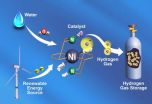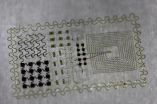(Press-News.org) For decades, scientists have studied a laboratory mouse model that develops signs of the paralyzing disease amyotrophic lateral sclerosis (ALS) as they age. In a new study appearing in Nature Biotechnology, investigators at Nationwide Children's Hospital have developed a new model of ALS, one that mimics sporadic ALS, which represents about 90 percent of all cases.
ALS, commonly known as Lou Gehrig's disease, is characterized by the death of motor neurons, which are muscle-controlling nerve cells in the spinal cord. As these neurons die, the body's voluntary muscles weaken and waste away; death within five years of diagnosis is common. Only about 10 percent of ALS cases are familial meaning the disease runs in the family. The majority of ALS cases are sporadic, with no family history.
Mutations in the SOD1 gene are found in about one-fifth of people with familial ALS, and for decades, experts have theorized that the gene holds clues to sporadic ALS. Laboratory mice carrying human SOD1 mutations develop signs of ALS as they age, and have been widely used to investigate the causes and potential treatments for the disease. At the same time, however, researchers have questioned whether SOD1 mice are useful and whether SOD1 itself is relevant for understanding sporadic ALS. While dozens of potential therapies have shown promise in the mice, most have failed in patients.
"The mouse models capture a type of familial ALS that accounts for only two percent of all cases. The field has begged for new disease models that can provide a clear window into sporadic ALS," said senior author Brian Kaspar, PhD, principal investigator in the Center for Gene Therapy of The Research Institute at Nationwide Children's Hospital.
Nationwide Children's researchers attempted to develop such a model by isolating cells from patients' spinal tissue within a few days after death.
First, the team isolated neural progenitor cells from post-mortem spinal tissue of patients with ALS. Neural progenitor cells are the "parent" cells of neurons and astrocytes, cells of the central nervous system. They then coaxed these progenitor cells to develop into astrocytes. Next, the team combined the patient-derived astrocytes with mouse motor neurons. At first, the motor neurons grew normally, but after four days, they began to degenerate. By five days, the number of motor neurons reduced by about half compared to motor neurons that had been grown with control astrocytes. Similar results were seen when the motor neurons were grown with astrocytes from a patient with familial ALS, or with a cell culture broth that had been conditioned by astrocytes from any of the ALS patients. This suggests the ALS-derived astrocytes are releasing one or more unknown toxins.
Further experiments revealed that inflammatory responses and SOD1 may play a critical role in this toxicity. These results suggest that replacing astrocytes may be just as important as replacing motor neuron lost to the disease and that astrocytes and SOD1 need further investigation as targets for therapy.
"It has been a long road, but the hard work starts now," said Dr. Kaspar. "We still need to confront fundamental questions about what is happening to astrocytes and how they are killing motor neurons. And the ultimate goal is to identify therapies that will translate into helping humans."
###
The research was funded in part by the National Institutes of Health's National Institute of Neurological Disorders and Stroke, including a $1.7 million stimulus grant made possible by the American Recovery and Reinvestment Act.
Human-cell-derived model of ALS provides a new way to study the majority of cases
2011-08-12
ELSE PRESS RELEASES FROM THIS DATE:
Low vitamin D linked to earlier first menstruation
2011-08-12
ANN ARBOR, Mich.---A study links low vitamin D in young girls with early menstruation, which is a risk factor for a host of health problems for teen girls as well as women later in life.
Researchers from the University of Michigan School of Public Health measured the blood vitamin D levels in 242 girls ages 5-12 from Bogota, Colombia, and followed them for 30 months. Girls low on vitamin D were twice as likely to start menstruation during the study than those with sufficient vitamin D, said epidemiologist Eduardo Villamor, associate professor in the U-M SPH.
This ...
Scientists explore the role of aeroecology in bat conservation and ecosystem health
2011-08-12
Golf courses and coffee plantations are some of the unlikely bat habitats that could be considered in conservation plans, say scientists presenting research at the Ecological Society of America's (ESA) 96th Annual Meeting from August 7-12, 2011. Using Doppler weather radar and other technologies relatively new to the field of ecology, ecologists will discuss the role of atmospheric conditions in bat behavior and the effectiveness of acoustic deterrents in reducing bat fatalities at wind farms. ESA's August 2011 meeting will take place in Austin, Texas, home to North America's ...
Metabolomics as a basis for gender-specific drugs
2011-08-12
Analyses of the metabolic profile of blood serum have revealed significant differences in metabolites between men and women. In a study to be published on August 11 in the open-access journal PLoS Genetics, scientists at the Helmholtz Zentrum München have concluded that there is a need for gender-specific therapies.
Gender-specific therapies may be required for some diseases as there are significant differences between male and female metabolism. Such differences were shown to exist for 101 of the 131 metabolites – above all in lipid and amino acid species – in the sera ...
Researchers fight cholera with computer forecasting
2011-08-12
AUSTIN, Texas – Just as the rainy season is driving a new surge of cholera cases in Haiti, a new computational model could forecast where outbreaks are likely to occur.
Researchers at Ohio State University are working with the Centers for Disease Control and Prevention (CDC) on the project, in the hopes of targeting anti-cholera efforts where they are most needed in the earthquake-ravaged country.
Just back from a 10-day trip to the Artibonite Valley in Haiti, Ohio State researcher Marisa Eisenberg described the model's early results at the Ecological Society of America ...
Polar climate change may lead to ecological change
2011-08-12
Ice and frozen ground at the North and South Poles are affected by climate change induced warming, but the consequences of thawing at each pole differ due to the geography and geology, according to a Penn State hydrologist.
"The polar regions, particularly the Arctic, are warming faster than the rest of the world," Michael N. Gooseff, associate professor of civil and environmental engineering, told attendees today (Aug. 11) at the 96th annual meeting of the Ecological Society of America in Austin, Texas. "As a consequence, polar ecosystems respond directly to changes ...
Like humans, chimps are born with immature forebrains
2011-08-12
In both chimpanzees and humans, portions of the brain that are critical for complex cognitive functions, including decision-making, self-awareness and creativity, are immature at birth. But there are important differences, too. Baby chimpanzees don't show the same dramatic increase in the volume of prefrontal white matter in the brain that human infants do.
Those are the conclusions of a study reported in the August 11th Current Biology, a Cell Press publication, that is the first to track the development of the chimpanzee brain over time and to make the comparison to ...
For bugs within bugs within mealybugs, life is a 'patchwork'
2011-08-12
Bacteria may have bad reputations but in fact, all animals -- us included -- rely on them in critical ways. In the case of sap-feeding insects, intimate associations with microbes offer a source for essential nutrients that their sugary diets just don't include. Now, researchers reporting in the August 11th Current Biology, a Cell Press publication, have new insight into organisms that have taken this symbiotic lifestyle to the extreme; they have sequenced the genomes of two species of bacteria that live together, one inside of the other, inside mealybugs.
The effort ...
Catalyst that makes hydrogen gas breaks speed record
2011-08-12
RICHLAND, Wash. -- Looking to nature for their muse, researchers have used a common protein to guide the design of a material that can make energy-storing hydrogen gas. The synthetic material works 10 times faster than the original protein found in water-dwelling microbes, the researchers report in the August 12 issue of the journal Science, clocking in at 100,000 molecules of hydrogen gas every second.
This step is just one part of a series of reactions to split water and make hydrogen gas, but the researchers say the result shows they can learn from nature how to control ...
Stick-on tattoos go electric
2011-08-12
VIDEO:
The video describes the new epidermal electronics system and shows how it is applied to the skin.
Click here for more information.
Through a combination of careful theoretical modeling and precise micro-manufacturing, a team of engineers and scientists has developed a new type of ultra-thin, self-adhesive electronics device that can effectively measure data about the human heart, brain waves and muscle activity – all without the use of bulky equipment, conductive ...
URALCHEM HOLDING P.L.C. Reports The First Half Of Year 2011 Unaudited IFRS Financial Results
2011-08-12
- Revenue increased to US $ 1.035 billion, compared to US $ 663 million
in H1 2010
- Operating profit increased to US $ 288 million, compared to US $ 83 million
in H1 2010
- Adjusted EBITDA grew to US $ 337 million, compared to US $ 137 million
in H1 2010
- Net profit amounted to US $ 244 million, compared to net loss of US $ 13 million in H1 2010
URALCHEM Holding P.L.C. (hereinafter URALCHEM Holding or the Company), a Cypriot holding company of the URALCHEM Group (hereinafter called the Group), one of the largest producers of nitrogen and phosphate fertilisers ...

